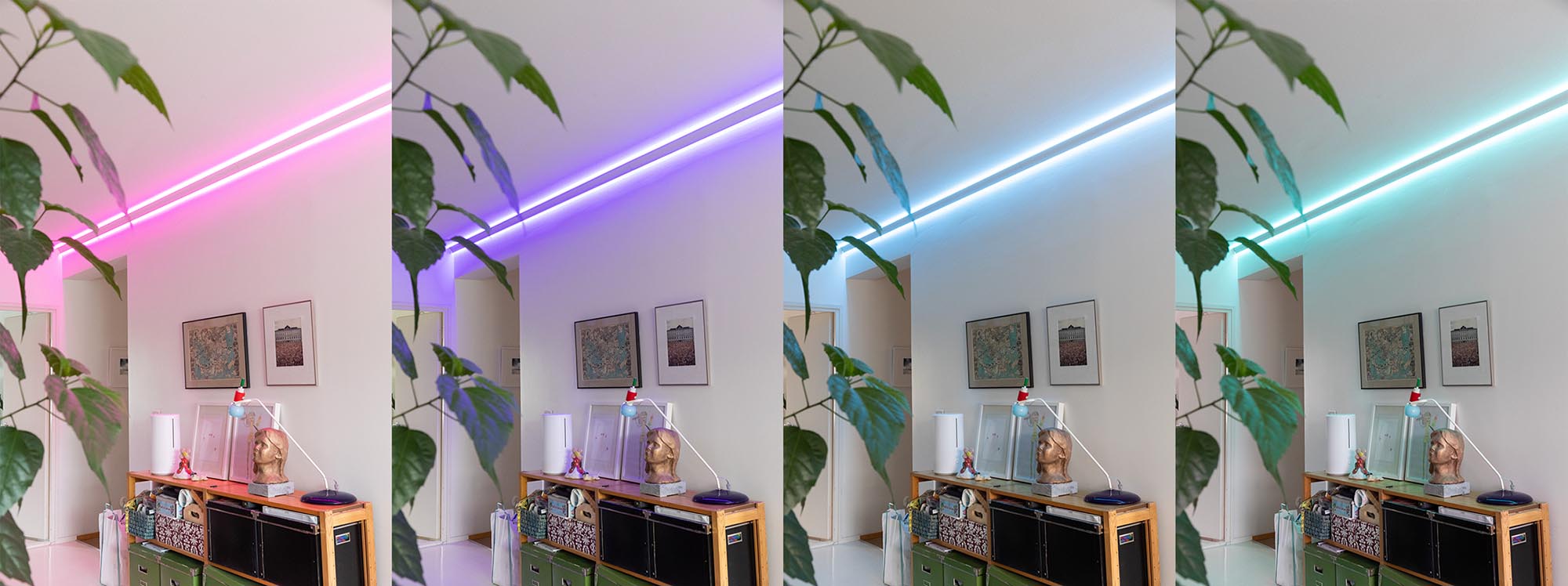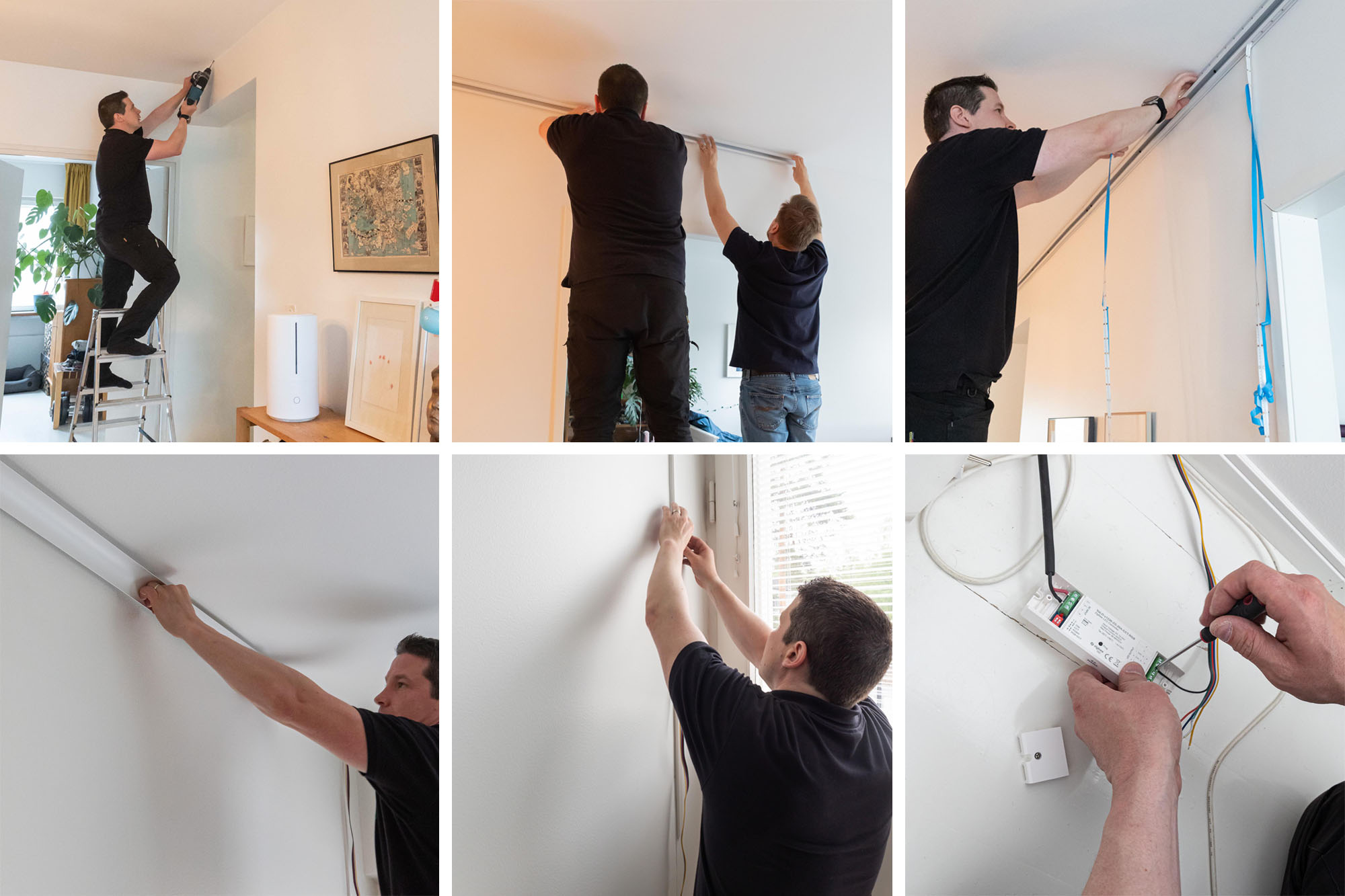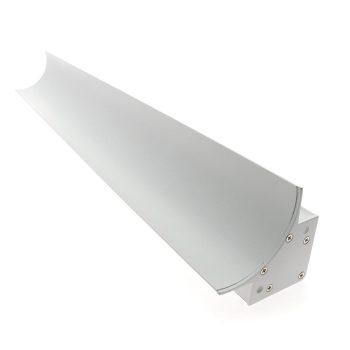Summarize
- A wirelessly controlled RGB+CCT LED strip was installed in the living room
- The LED strip offers various shades of white as well as a full range of colors
- The light was mounted on an arc profile, which indirectly directs the light
- Zigbee system enables lighting control via mobile devices
- The installation took about three hours, including fixing the profiles
We live in an apartment built in the 1960s, so our living room has only two ceiling light points available. The living room is relatively deep, and especially during winter, one end of the room feels quite dark. Initially, we thought about installing spotlights in the living room, for more efficient lighting. However, the room height in the apartment is relatively low. Lowering the ceilings further did not seem a sensible option. The alternative was to install a LED strip in the living room.
Efficient and comfortable lighting for your living room
We decided that the best solution for our space would be to install an LED strip along the entire length of the long wall. Our goal was to control the LED strip wirelessly, as this is a retrofit and the apartment was renovated just five years ago. Wireless switches eliminate the need for wall chasing. It also makes it easy to adjust color, temperature, and brightness.
RGB+CCT led strip
We chose an RGB+CCT LED strip, which allows for a full range of white tones from warm to cool (CCT 2500K–6500K), as well as a variety of colors (RGB). RGB+CCT led strip was chosen because of its versatility. We wanted the white from the LED strip to have a good colour rendering (CRI 98). In RGB+W strips, getting this warmer light clean is a challenge, as it is usually a combination of 4000K white and amber LEDs. I think a more beautiful warm white light is achieved with CCT LEDs.


Indirect-3 curved profile
Of the profiles, we chose an arc profile that gives light in the direction of the edge. The light is directed from the profile along the wall and ceiling. The installation is made at the junction of the wall and ceiling. One of the reasons we chose this profile was that we wanted the solution to have a high light output. This was achieved thanks to the fact that the profile comes with two strips.
We have a profile that runs the length of the living room, so it’s about 7.3m long. The installation consists of three profiles mounted end-to-end. The profiles come in 2.52-meter lengths and can be cut to the desired size. The profile has two mounting channels for LED strips, each fitted with white diffusers that help soften and evenly distribute the light. If the total profile length exceeds 2.52 meters, the LED strips should be attached only after the profile has been mounted to the wall.
The surface of the profile is a beautiful matte white, with a texture that resembles sandblasted material. It’s best to mount the profile at the corner by drilling into the wall. The curved cover of the profile is removed during installation. The curved cover can be reattached by simply pressing it back into the profile.
Zigbee wireless lighting control
RF or Zigbee devices are used to control CCT+RGB LED strips. We chose Zigbee because we’re considering getting a Zigbee bridge (such as Philips HUE) later, which would allow us to control the lighting with mobile devices.
The light is currently controlled by a wireless CCT+RGB button, which is paired with a 24V Zigbee receiver. The receiver was installed between a 240W 24V IP65 transformer and the LED strips, and it was paired with the wireless control button. For now, a receiver is always used between the transformer and the LED strip when working with RGB+CCT LED strip. This is because transformers with a built-in receiver can only control single-color, CCT, or RGB+W LED strips — but not CCT+RGB strips. So, the installed setup is: > – receiver – >.
If you want to schedule or program the lighting, or control it with a mobile device, you’ll also need a Zigbee bridge or hub — such as Azoula, Philips Hue, Samsung SmartThings, or ConBee II — which can be controlled, for example, via a smartphone with Home assist. Home assistant can be used to control many other things besides lights, such as cameras, thermostats and can be loaded with a The choice depends on how precisely you want to control the light, for example. whether we want the lights to match the circadian rhythm. More information about circadian rhythm.
In addition to this luminaire, our idea is to control the other luminaires in our apartment as we make small upgrades to them. Our plans include CCT adjustable lights and 230V receivers for controlling the lights.
LED strip installation in the living room
Although 24V products with a plug-in power supply can technically be installed by the user, we decided to hire a professional for the installation to save time and avoid frustration. The installation of the RGB+CCT LED strip, mounting the profiles, and other related tasks took about three hours, part of which was spent aligning and adjusting the profiles due to our slightly curved wall. Below the images, I’ll outline the installation steps and other important considerations.

1. Selecting products
When selecting the products, we took precise measurements of the installation site, as we knew we wanted the products to be custom-cut to specific lengths by LedPaja. We chose the products based on our preferences, which included color adjustment (RGB), color temperature adjustment (CCT), dotless light, and a high color rendering index. We also wanted the lighting to be powerful enough to serve as additional illumination.
2. Making the LED strip and profiles to measure at LedPaja
In this project, LedPaja drilled holes in the profiles ready for installation. The strips and profiles were made to the desired measurements. The LED strips were also connected to each other so that only one cable would run from the profile to the transformer instead of two. This step can also be done by a skilled solderer, but it’s important to keep in mind that a six-wire cable needs to be soldered onto a small LED strip. That’s why I left the soldering of the RGB+CCT LED strip to the electrician.
The strips were pre-attached with adhesive to a 2.52 m profile in advance, and the remaining strips were left coiled, waiting to be fixed into the profiles once all the profiles are mounted to the ceiling. This was done to ensure that the end section could also be finished neatly in advance. A plug was also pre-installed on the driver.
3. The installer arrives at the site and checks the products
One installer was enough for us, as my husband and I assisted during the fitting of the profile to the ceiling. Since the profiles are 2.52 meters long, two people are needed at a certain stage of the installation to keep the process moving efficiently. The LED strips were tested before starting the installation, just in case any of the products had been damaged during transport.
4. Drilling holes in the wall at the locations of the pre-drilled holes
The positions of the profile’s holes were marked on the wall, and the holes were then drilled. Wall plugs were inserted to ensure a secure installation. The mounting method depends on the wall material.
5. Mounting the profile into the drilled and plugged holes
At this stage of the installation, an extra pair of hands was needed to help the installer keep the profile steady during mounting. This is especially important for installations over 2.52 meters in length, where the profiles are mounted end to end.
6. Installation of the LED strip into the profiles and testing
Once all the profiles were mounted, the LED strips could be adhered along the full length of the profiles. The LED strips were tested again at this stage to ensure that none of them had been damaged during installation. Installing the LED strip is easy because it comes with adhesive tape already attached.
The curved cover of the profile was also attached at this stage. Attaching the cover of the curved profile requires installing it at the correct angle and snapping it into place. This takes a bit of force and an extra pair of hands to hold the other end of the cover. Since our walls were slightly curved — typical of 1960s construction — we had to make some adjustments, such as loosening a few screws. We also carefully aligned the curved cover to ensure that the arch sat nicely at the joints.
For optimal results, the diffusers and curved covers should be positioned so that their joints do not align with the ends of the profiles. However, the curvature of our wall was such that this was not worthwhile.
7. Running the wires neatly from the profile to the driver.
To run the wires down, I bought a sleek wire grab from a hardware store to match the tone of our wall. Our installer would have found a gutter, but I wanted to get it myself. As there is a post inside our living room wall that is slightly different in height from the rest of the wall, the cable duct was nicely tucked into that corner and was very unobtrusive. The wiring of the RGB+CCT led strip is flat cable and very multicoloured, so it has to be hidden somewhere to make a neat installation.
8. Wireless control pairing between the controller (Zigbee) and the receiver.
The installer paired the button and receiver for me and would have paired it if necessary, e.g. Philips HUE app. However, it is worth expressing such wishes when ordering the installation or assembly.
{{collection items=”cct+rgb-led-strip-livingroom”}}
Read more:
Check out our LedPaja assembly service if you’re interested in custom-sized LED strip lighting.
Order the LedPaja installation service if you need help with the installation.
LED lighting expert
LedStore has been an expert in LED lighting since 2010. We have our own product design, so our products are technologically state-of-the-art.
Our focus is on lights with colour temperature control and high colour rendering. We do around 500 lighting designs in a year.
Remember that we are always ready to offer our help to you along the way, by email (myynti@ledstore.fi) and by phone (045 251 4510). As always, feel free to share photos of your own projects on social media using #ledstorefi on Instagram and ledstorefinland on Facebook. We love seeing the amazing things people create with our lighting, and it helps inspire other renovators and builders too! Did you know that our gallery already features over 3,500 photos of installations done with LedStore lighting?
LED Lighting Photo Gallery:
Product gallery: Pictures of PRODUCTS in different installation locations
Indirect light: Indirect light in different spaces
Room-specific: Light in different rooms
References: Complete houses that have been photographed



